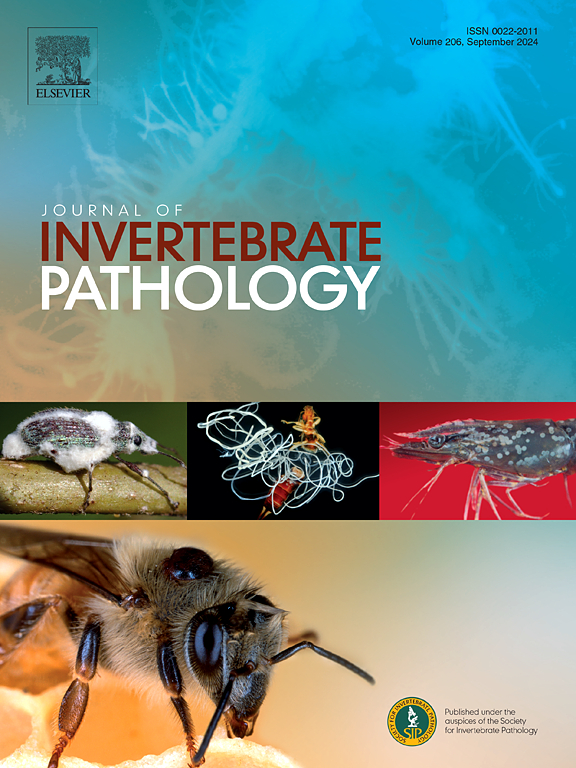The activation of caspases in immunocompetent cells is an important infection factor of the pathogenic fungus Conidiobolus coronatus (Entomophthorales: Ancylistaceae)
IF 2.4
3区 生物学
Q1 ZOOLOGY
引用次数: 0
Abstract
Apoptosis is a mechanism commonly used by pathogenic fungi to inhibit the host’s immune response. One opportunistic pathogen is Conidiobolus coronatus, which causes fungal infection in mammals and insects. In a study, larvae of Galleria mellonella were exposed to the pathogen for 24 h. After this exposure, some larvae were used for hemolymph collection (F24), while others were incubated for an additional 24 h (F48). The activity of caspase-9 and caspase-3-like proteins in hemocytes was measured using a colorimetric method. The changes in caspase concentration were calculated using ELISA tests. Immunocytochemical analyses were employed to show changes in the levels of the examined proteins in both their pro- and active forms. Fluorescence microscopy was used to detect changes in cultured hemocytes and flow cytometry analysis was conducted to detect both forms of caspases in freshly collected hemocytes. To evaluate the effect of fungal infection, caspase inhibitors (Z-DEVD-FMK and Z-LEHD-FMK) were injected into the larvae, and their impact on insect development and resistance to fungal infection was determined. The exposure of larvae to the entomopathogen increased the detection levels, concentrations, and activity of both caspase-like proteins in hemocytes during fungal infection. The research has indicated that inhibition of these proteins disrupts larval development and increases resistance to infection. These results suggest that apoptosis might be an important mechanism for a pathogen to inhibit the insect immune response. Given the similarities between insects’ and mammals’ innate immune responses, the presented results may indicate a potential mechanism of fungal pathogenicity in both groups.

免疫活性细胞中半胱天冬酶的激活是病原菌冠状孢子虫(Conidiobolus coronatus)的重要感染因子。
细胞凋亡是病原真菌抑制宿主免疫应答的一种常用机制。一种机会致病菌是冠状孢子虫(Conidiobolus coronatus),它能引起哺乳动物和昆虫的真菌感染。在一项研究中,将mellonella Galleria的幼虫暴露在病原体中24小时。暴露后,一些幼虫用于血淋巴收集(F24),而另一些幼虫则再孵育24小时(F48)。用比色法测定血细胞中caspase-9和caspase-3样蛋白的活性。采用酶联免疫吸附试验计算caspase浓度变化。采用免疫细胞化学分析来显示检测蛋白在其前和活性形式中的水平变化。用荧光显微镜检测培养血细胞的变化,用流式细胞术分析新采集的血细胞中两种形式的半胱天冬酶。为了评价真菌侵染的效果,将半胱天冬酶抑制剂Z-DEVD-FMK和Z-LEHD-FMK注射到幼虫体内,测定其对昆虫发育和对真菌侵染的抗性的影响。在真菌感染期间,暴露于昆虫病原体的幼虫增加了血细胞中两种caspase样蛋白的检测水平、浓度和活性。研究表明,抑制这些蛋白质会破坏幼虫的发育,增加对感染的抵抗力。这些结果提示,细胞凋亡可能是病原菌抑制昆虫免疫应答的重要机制。鉴于昆虫和哺乳动物先天免疫反应的相似性,本研究结果可能提示真菌在两组中致病的潜在机制。
本文章由计算机程序翻译,如有差异,请以英文原文为准。
求助全文
约1分钟内获得全文
求助全文
来源期刊
CiteScore
6.10
自引率
5.90%
发文量
94
审稿时长
1 months
期刊介绍:
The Journal of Invertebrate Pathology presents original research articles and notes on the induction and pathogenesis of diseases of invertebrates, including the suppression of diseases in beneficial species, and the use of diseases in controlling undesirable species. In addition, the journal publishes the results of physiological, morphological, genetic, immunological and ecological studies as related to the etiologic agents of diseases of invertebrates.
The Journal of Invertebrate Pathology is the adopted journal of the Society for Invertebrate Pathology, and is available to SIP members at a special reduced price.

 求助内容:
求助内容: 应助结果提醒方式:
应助结果提醒方式:


